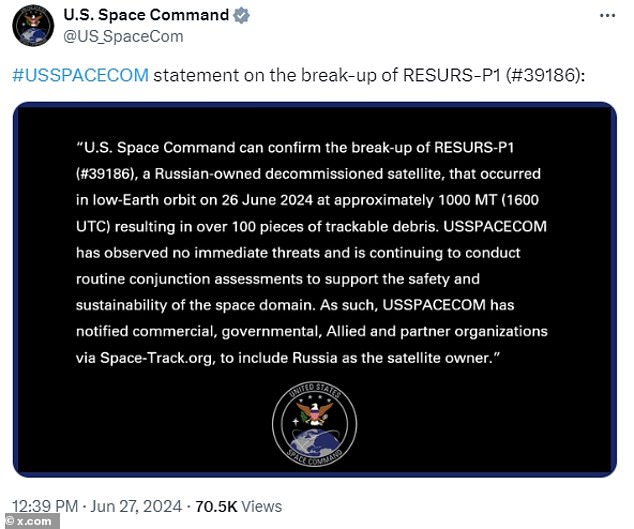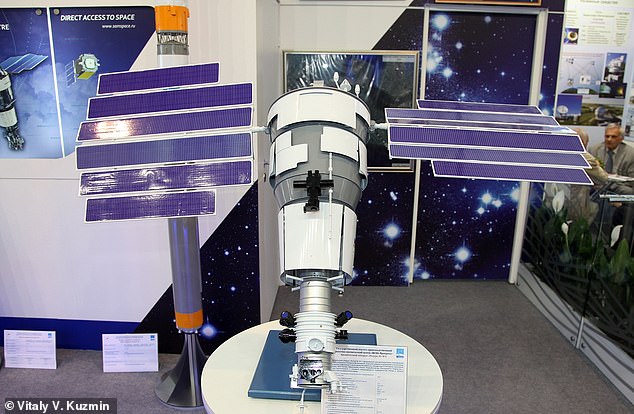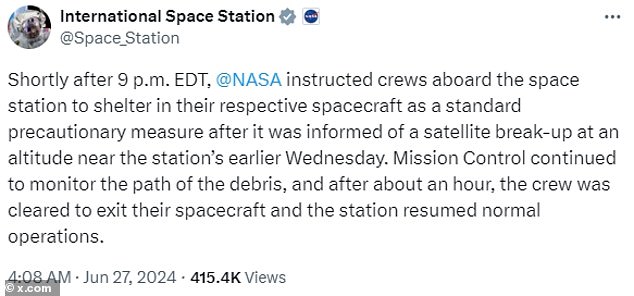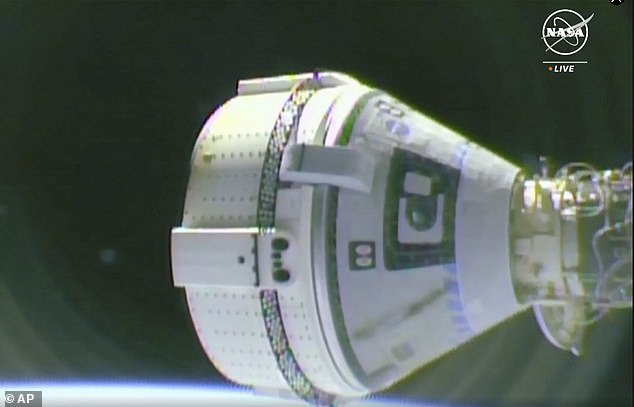Astronauts aboard the ISS are forced to take cover after a defunct Russian satellite broke up in orbit – scattering more than 100 bits of debris towards the space station
Astronauts aboard the International Space Station (ISS) were forced to take cover after a malfunctioning Russian satellite disintegrated in space.
US space agencies reported that the Russian spacecraft ‘Resurs-P1’ broke up into at least 100 pieces around 10:00 MT (16:00 BST) on Wednesday.
The nine astronauts on board the ISS – including the two ‘stranded’ Boeing passengers – had to take cover for an hour due to the risk of being hit.
Resurs-P1 has been inactive for almost three years, but could have suddenly blown up due to a fuel leak on board or an impact with another piece of “space junk.”
It is unclear whether the Resurs-P1 debris ultimately impacted the ISS or whether astronauts could have been injured if they had been on a spacewalk.
A defunct Russian satellite has broken up into more than 100 pieces of debris in orbit around Earth, forcing astronauts on the International Space Station (pictured) to take shelter for about an hour.

US Space Command, which operates a global network of space radars, said the satellite immediately created “more than 100 pieces of traceable debris”
According to the US Space Command, which operates a global network of space radars, the satellite immediately created “more than 100 pieces of traceable debris.”
“USSPACECOM has not observed any immediate threats and continues to conduct routine engagement assessments to support the security and sustainability of the space domain,” a statement said. posted on X.
“As such, USSPACECOM has notified commercial, government, allied and partner organizations through Space-Track.org to include Russia as the owner of the satellite.”
NASA instructed crews aboard the space station to shelter in their respective spacecraft “as a standard precaution.”
It is thought that these spacecraft docked with the ISS – Soyuz, Crew Dragon and Boeing’s Starliner – offer better protection from debris than the ISS itself.
The Russian space agency Roscosmos, which operated the satellite, did not respond to a request for comment or even mention the event on its social media channels.
The satellite’s breakup occurred at an altitude of about 355 km (220 miles) in low Earth orbit, a region where thousands of small to large satellites operate, including SpaceX’s massive Starlink network and China’s Tiangong space station.

Resurs-P1 was a Russian satellite launched into space by the Russian space agency Roscosmos in June 2013. The photo shows a reduced model of Resurs-P1

According to NASA’s X account for the International Space Station, the instruction to the crew to take shelter was a “precautionary measure”
By Thursday afternoon, radars from the American space tracking company LeoLabs had detected at least 180 pieces of debris from Resurs-P1.
“Due to the low orbit of this debris cloud, we estimate it will take weeks to months for the hazard to pass,” LeoLabs told Reuters.
There are no immediate details about the cause of the disintegration of the Russian Earth observation satellite RESURS-P1, which ceased operations in 2021.
But Jonathan McDowell, an astronomer at the Harvard-Smithsonian Center for Astrophysics, speculated that an explosion could have occurred on board.
“Such events can range from the release of a few low-energy pieces of debris due to flaking insulation, to energetic events resulting from a small impact or the explosion of an on-board battery,” he said. posted on X.

NASA instructed crews aboard the space station to take shelter in their respective spacecraft “as a standard precaution.” These spacecraft docked with the ISS — Soyuz, Crew Dragon and Boeing’s Starliner (pictured) — are said to provide better protection from debris
Events like these compound the overall problem of “space junk”: a swirling mass of spaceship fragments, machines, and other man-made objects orbiting Earth.
Dead satellites remain in orbit until they descend into Earth’s atmosphere years later to die a fiery death.
Less often, they fly to a “graveyard orbit” about 36,000 km from Earth to reduce the risk of collision with active satellites.
Resurs-P1 lowered its altitude through layers of other active satellites before eventually re-entering the atmosphere, Reuters reported.
